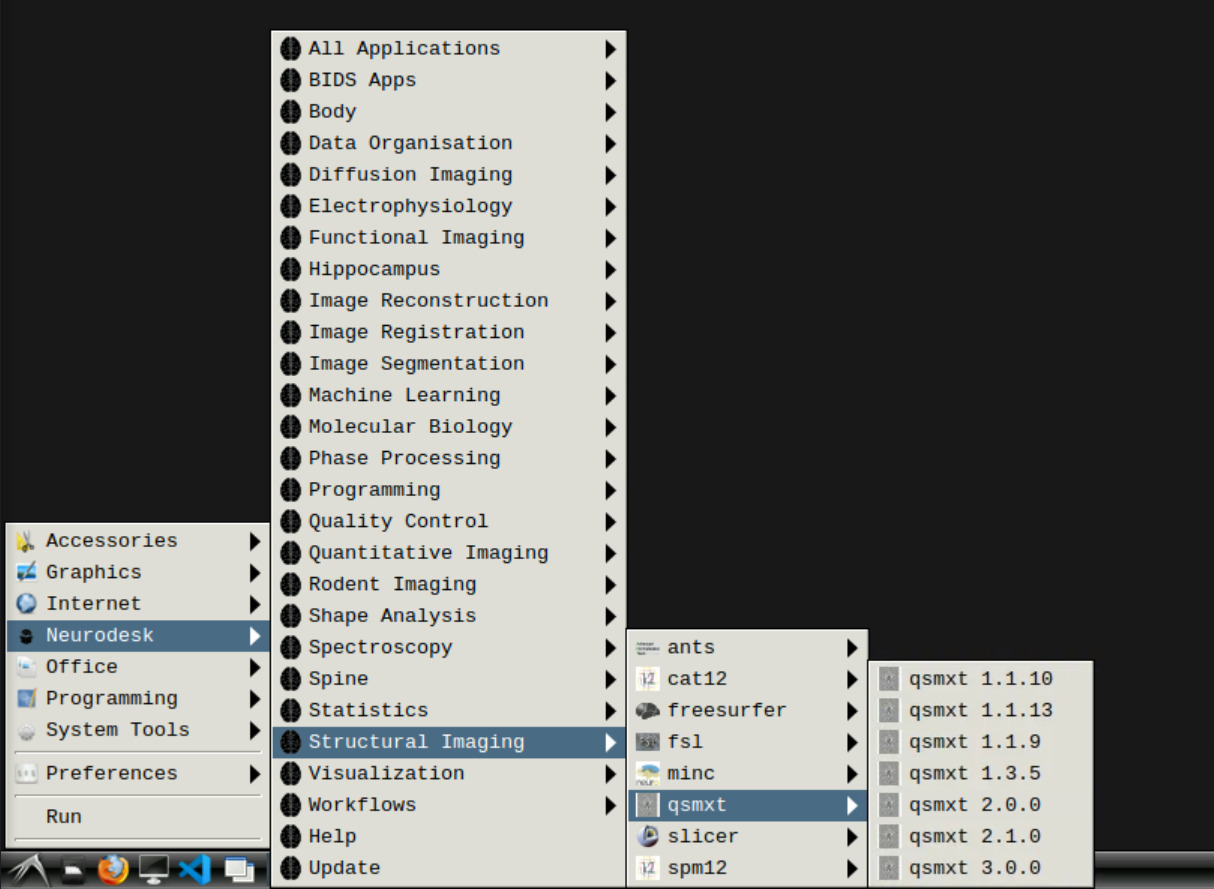Installation
Quickstart via Neurodesk
QSMxT is available via Neurodesk. Using Neurodesk Play, you can access QSMxT in your browser without any installation.
Once started, QSMxT is available in Neurodesk’s module system and via the applications menu:

Updating QSMxT in Neurodesk
To use the latest version of QSMxT within an older version of Neurodesk, use:
bash /neurocommand/local/fetch_and_run.sh qsmxt 8.2.2 20251216
Docker container
If you prefer to use a Docker container, the following commands will install QSMxT locally:
Windows:
docker run -it -v C:/neurodesktop-storage:/neurodesktop-storage vnmd/qsmxt_8.2.2:20251216
Linux/Mac:
docker run -it -v ~/neurodesktop-storage:/neurodesktop-storage vnmd/qsmxt_8.2.2:20251216
HPC installation
QSMxT can be installed on an HPC or Linux machine using transparent apptainer. Transparent apptainer installs QSMxT using an Apptainer container and exposes the underlying tools to the host environment, which is necessary for HPCs using PBS Graph or SLURM.
- Install or load apptainer on your HPC. Test if it works by executing ‘apptainer –version’.
- Install the QSMxT container via transparent apptainer:
git clone https://github.com/astewartau/transparent-apptainer qsmxt_8.2.2_20251216
cd qsmxt_8.2.2_20251216
./run_transparent_apptainer.sh --container qsmxt_8.2.2_20251216.simg
source activate_qsmxt_8.2.2_20251216.simg.sh
- NOTE: You must have sufficient storage available in
$APPTAINER_TMPDIR(by default/tmp),$APPTAINER_CACHEDIR(by default$HOME/.apptainer/cache), and the repository directory to store the QSMxT container.- Check if you have conda installed using ‘which conda’. If it is installed you can skip the first steps of this:
#Install Miniforge in the current directory. Make sure this directory has enough free space. (skip if conda is already installed)
wget https://github.com/conda-forge/miniforge/releases/latest/download/Miniforge3-Linux-x86_64.sh
bash Miniforge3-Linux-x86_64.sh -b -p ~/miniforge3
source ~/miniforge3/etc/profile.d/conda.sh
export PATH=~/miniforge3/bin/:${PATH}
#create conda environment for qsmxt
conda create -n qsmxt python=3.8
conda activate qsmxt
pip install qsmxt==8.2.2
- Run QSMxT commands directly (see using QSMxT). Use the
--pbsand--slurmflags with your account string and group to run on an HPCs supporting PBS and SLURM.
Bare metal installation
We recommend the use of software containers for reproducibility and ease of use. However, QSMxT can be installed manually. Please see the detailed instructions for generating the container here.
Older versions and release notes
You can find the software versions and container dates on our Docker page here.
You can find detailed release notes on the GitHub releases page here.